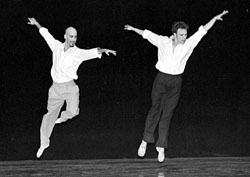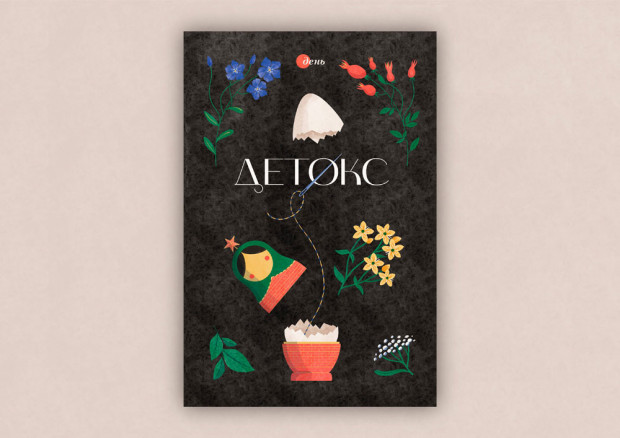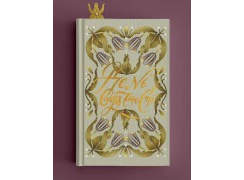Nijinsky Returns

On March 11 the National Opera hosted the First Vaslav Nijinsky International Dance Festival. Symbolically, the gala concert began and ended with scenes from the Chopiniana by students at Kyiv’s School of Choreography. There are eyewitness accounts of Nijinsky’s legendary grands jetes making one believe he was suspended in midair. At the start of his career the great dancer was unmatched in his classical repertoire and then was as magnificent in modern choreography. It was thus the concert organizer, the Center for Contemporary Choreography, stressed the succession of generations. Regrettably, not all of the stars mentioned in the posters attended the event. Everybody had looked forward to seeing Volodymyr Derevyanko, former soloist with the Bolshoi, currently working in Dresden. He never turned up, reportedly owing to visa problems. Despite his absence, the organizing committee mentioned him as the best dancer, which looked rather strange, as the audience had to be content only with memories (those that had them, of course). Olena Horbach, his partner, was asked to convey the commemorative medal to the dancer. Practically every participant in the event was awarded a diploma of honor, perhaps as a way to promote subsequent cooperation. As it was, Ukrainian performers — soloists with the National Opera, Kharkiv Opera and Ballet Theater, Choreography School, and Ukrainian Dance Academy students — carried the bulk of the concert.
“The main thing for world ballet and our capital city is that the two most brilliant choreographers, Nijinsky and Lifar, both born in Kyiv, transformed the twentieth century art of ballet,” says Yuri Stanishevsky, theatrical critic and president of the Ukrainian Dance Academy. “They blazed the trail for modern trends and new progressive choreographic forms. Vaslav Nijinsky was not only a prominent classical dancer, but also the founder of a whole new ballet trend. He staged the first modern ballet, Le sacre du printemps [The Rite of Spring, 1913] which is still played by the Grand Opera and many other companies across the world. Even in 1913, Nijinsky foresaw the development of the ballet as art. His baton was picked up by Serge Lifar who in Diaghilev’s Ballets Russes (where Vaslav’s talent would flourish) continued on the road of modern choreography. Before them no one had been able to combine classical and new forms of plasticity. The two dancers’ talent shed a new brilliant light on the ballet. Remarkably, the names of Nijinsky and Lifar are returning to Ukraine; their names are remembered, and posterity reveres their heritage.”
Festivals stimulate the development of the ballet theater. Apart from Ukrainian and Russian choreography, the audience was offered works by the Sinopia International Theater (Switzerland), Atelje-212 (Yugoslavia). Etien Frey, recipient of the best European choreographer award, showed a eurhythmia plastique, a new trend in modern ballet.
In the first part of the festival evening the audience was offered scenes from classical ballets. In particular, the pas de deux from Adan’s Giselle by Kyiv’s Hanna Dorosh and Ivan Putrov currently with London’s Covent Garden, where Vaslav Nijinsky had once made a triumphant appearance as Albert; a scene from Stravinsky’s Firebird (staged by Viktor Lytvynov), excellently performed by Tetiana Holiakova and Ihor Bulychov, and a duet from Tchaikovsky’s Swan Lake by Olena Horbach and Maksym Chepyk, soloists with the Dresden and National Operas were warmly received by the audience.
In the second part of the concert the audience was acquainted with modern choreography, although to experts most of the numbers were familiar (like Petrushka, staged by Alla Rubina and performed by Kharkiv dancers, and the tango from The Golden Age staged by Yuri Hryhorovych with soloists Anna Kushnareva and Maksym Motkov). Everybody anticipated the appearance of the American Robert Russell and the Swiss Etien Frey who danced scenes from Zorba and You Will See composed by Mikis Theodorakis. Original dramatizations and controversial in many respects; they seemed somewhat inferior to what Etien Frey had to show last year. Adrienne Yang’s choreography was more like an acrobatic number, even though it looked quite out of the ordinary. “Constant movement, up and down, is characteristic of modern choreography,” says choreographer Viktor Lytvynov, “and if it follows a direct line this will mean a stop. The system we know as classical has taken decades to shape. There is time for experimentation, selection, accumulation, and presentation of the results. We are not as yet well acquainted with modern choreographic trends in different countries. We are still in the selection and accumulation phase.” Even if not everything turned out as planned, the main thing is that the name of Vaslav Nijinsky has returned to his native land. Also, the festival was eloquent evidence that we have excellent young talent quite capable of combining past experience and the future.






